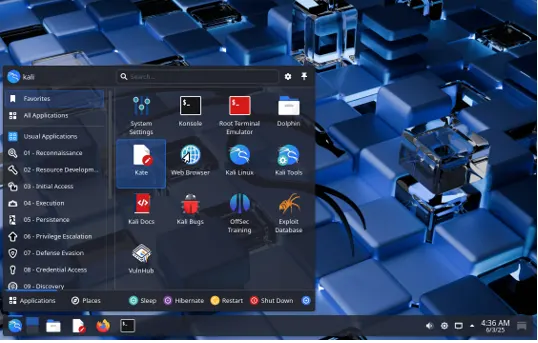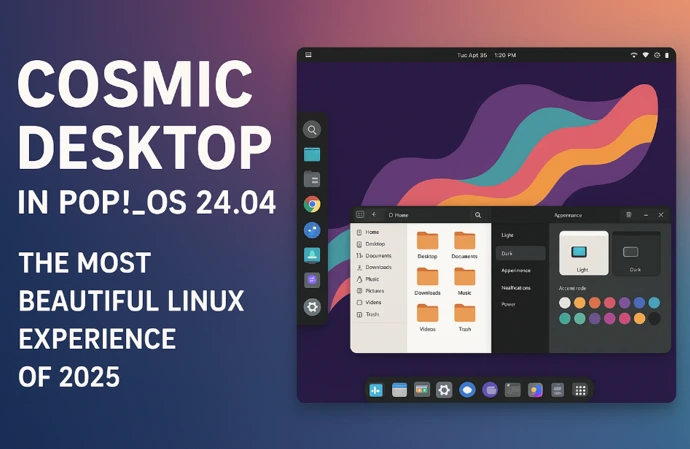
Kali Linux 2025.2 Unleashed: Revamped Menu, New Tools, and Car Hacking with CARsenal
Hey there, cybersecurity enthusiasts! Get ready to explore Kali Linux 2025.2 Unleashed, the latest powerhouse release from Offensive Security that’s shaking up the penetration testing world. Dropped on June 13, 2025, this update is loaded with a revamped menu aligned with the MITRE ATT&CK framework, 13 cutting-edge tools, and jaw-dropping features like car hacking with CARsenal and Wi-Fi injection on the TicWatch Pro 3 smartwatch. Whether you’re a seasoned pentester or just diving into the world of ethical hacking, Kali Linux 2025.2 Unleashed is here to supercharge your toolkit.
In this deep dive, we’ll unpack everything you need to know about this game-changing release, from desktop upgrades to NetHunter innovations. Let’s jump in!
What’s New in Kali Linux 2025.2?
Kali Linux 2025.2 builds on the success of its predecessor, Kali 2025.1a, and introduces a slew of enhancements designed to streamline workflows, improve usability, and expand the toolkit available to security professionals. Here’s a quick overview of the major updates, which we’ll explore in detail throughout this post:
- Revamped Kali Menu: Reorganized to align with the MITRE ATT&CK framework for intuitive tool navigation.
- 13 New Tools: Including Azurehound, BloodHound CE ingestors, and more.
- Desktop Updates: GNOME 48 and KDE Plasma 6.3 bring modern aesthetics and functionality.
- Kali NetHunter Advancements: Smartwatch Wi-Fi injection on TicWatch Pro 3 and car hacking with CARsenal.
- Community Contributions: New wallpapers, mirrors, and active community involvement.
- BloodHound Community Edition: Upgraded with a full set of ingestors for Active Directory reconnaissance.
Let’s break down each of these features to understand what makes Kali Linux 2025.2 so exciting.
A Revamped Kali Menu: MITRE ATT&CK Framework Integration
One of the standout features of Kali Linux 2025.2 is the complete overhaul of the Kali Menu. For years, the menu structure was based on the legacy designs of BackTrack and WHAX, which, while functional, became increasingly cumbersome as the number of tools grew. The Offensive Security team has addressed this by reorganizing the menu to follow the MITRE ATT&CK framework, a globally recognized knowledge base of adversary tactics and techniques.

Why MITRE ATT&CK?
The MITRE ATT&CK framework provides a structured way to categorize tools based on real-world attack and defense scenarios. By aligning the Kali Menu with this framework, users can now find tools more intuitively, whether they’re performing reconnaissance, exploitation, or post-exploitation tasks. This change benefits both red teams (offensive security) and blue teams (defensive security), making it easier to locate the right tool for the job.
How It Works
The new menu is fully automated, replacing the previous manual management system that struggled to keep up with Kali’s expanding toolset. Tools are now grouped according to MITRE ATT&CK tactics, such as:
- Initial Access: Tools for gaining entry into systems.
- Execution: Tools for running malicious code.
- Persistence: Tools for maintaining access.
- Privilege Escalation: Tools for elevating permissions.
- Defense Evasion: Tools for bypassing security measures.
This reorganization is managed through a simple YAML file, which is open for community feedback and contributions. The Kali team encourages users to suggest improvements, such as renaming categories, moving tools, or adding missing ones, ensuring the menu evolves with the community’s needs.
Note: Kali Purple, the defensive-focused version of Kali, continues to follow the NIST CSF framework rather than MITRE ATT&CK, preserving its distinct structure for blue team workflows.
Why It Matters
For penetration testers, time is critical. The revamped menu reduces the time spent searching for tools, allowing professionals to focus on testing and analysis. Whether you’re a seasoned pentester or a beginner, the new structure makes Kali Linux 2025.2 more accessible and efficient.
13 New Tools to Supercharge Your Pentesting
Kali Linux 2025.2 introduces 13 new tools to its already extensive arsenal, catering to a wide range of cybersecurity tasks, from Active Directory reconnaissance to firmware analysis. Here’s a closer look at some of the standout additions:
- Azurehound: A BloodHound data collector for Microsoft Azure, ideal for cloud-based reconnaissance.
- Binwalk3: A firmware analysis tool for extracting and analyzing embedded files in firmware images.
- Bloodhound-ce-python: A Python-based ingestor for BloodHound Community Edition, enhancing Active Directory mapping.
- Bopscrk: A tool for generating smart and powerful wordlists for password cracking.
- Chisel-common-binaries: Prebuilt binaries for Chisel, a fast TCP/UDP tunnel over HTTP.
- Crlfuzz: A Go-based tool for scanning CRLF (Carriage Return Line Feed) vulnerabilities in web applications.
- Donut-shellcode: Generates position-independent shellcode from memory for advanced exploitation.
- Gitxray: Scans GitHub repositories and contributors for sensitive data leaks.
- Ldeep: An in-depth LDAP enumeration utility for Active Directory environments.
- Ligolo-ng-common-binaries: Prebuilt binaries for Ligolo-ng, a tunneling/pivoting tool using TUN interfaces.
- Rubeus: A raw Kerberos interaction and abuse tool for Active Directory attacks.
- Sharphound: A BloodHound CE collector tool for mapping Active Directory environments.
- Tinja: A CLI tool for testing web pages for template injection vulnerabilities.
Notable Tool Updates
In addition to new tools, Kali Linux 2025.2 includes updates to existing packages, such as PowerShell and code-oss, as well as new libraries to support the latest functionalities. The inclusion of xclip by default across all desktop environments simplifies workflows by allowing users to pipe command outputs directly to the clipboard. For example:
ip addr | xclip -sel clip
This command copies your IP address to the clipboard instantly, saving time during reporting or sharing.
Why These Tools Matter
The new tools reflect Kali’s commitment to staying ahead of the curve in cybersecurity. From cloud-based reconnaissance with Azurehound to car hacking with CARsenal (more on that later), these additions ensure Kali Linux remains a versatile platform for tackling modern security challenges.
Desktop Environment Upgrades: GNOME 48 and KDE Plasma 6.3
Kali Linux 2025.2 brings significant updates to its supported desktop environments, enhancing both aesthetics and functionality. While Xfce remains the default for its lightweight performance, users can opt for GNOME 48 or KDE Plasma 6.3, both of which have received substantial upgrades.
GNOME 48: Modern and Feature-Rich

GNOME 48 introduces several user-friendly features, including:
- Notification Stacking: Groups notifications for a cleaner interface.
- HDR Support: Improves color accuracy for high-dynamic-range displays.
- Dynamic Triple Buffering: Enhances performance for smoother animations.
- Enhanced Image Viewer: Replaces Evince with the new Papers app for document viewing.
A new GNOME VPN IP Extension ports the VPN IP indicator from Xfce (introduced in Kali 2024.1) to GNOME. This feature displays the IP address of your active VPN connection in the panel, and a single click copies it to the clipboard—a small but incredibly useful addition for pentesters.
KDE Plasma 6.3: Polished and Customizable

KDE Plasma 6.3 offers a modern, customizable desktop experience with:
- Fractional Scaling: Improves display clarity on high-DPI screens.
- Night Light Accuracy: Enhances color temperature adjustments for better visibility.
- System Monitoring: Provides detailed GPU and battery health data.
- Tiling Window Support: Appeals to users who prefer a tiled workflow.
Both desktop environments have been tuned to align with Kali’s sleek, dark aesthetic, ensuring a cohesive look across themes, boot menus, and login screens.
Community Wallpapers
Kali Linux 2025.2 includes new community wallpapers, showcasing stunning backgrounds created by the Kali community. To access these, install the kali-community-wallpapers package for a variety of designs to personalize your desktop.
Why It Matters
The desktop updates enhance the user experience, making Kali Linux 2025.2 not only a powerful tool but also a visually appealing and efficient platform. Whether you prefer GNOME’s simplicity or KDE’s customization, these updates ensure a smooth and productive workflow.
Kali NetHunter: Smartwatch Wi-Fi Injection and Car Hacking with CARsenal
Kali NetHunter, the mobile penetration testing platform for Android devices, continues to push boundaries with Kali Linux 2025.2. Two groundbreaking features steal the show: smartwatch Wi-Fi injection on the TicWatch Pro 3 and car hacking with the CARsenal toolkit.
Smartwatch Wi-Fi Injection on TicWatch Pro 3
For the first time, Kali NetHunter supports wireless injection on a smartwatch, specifically the TicWatch Pro 3 (all variants with the bcm43436b0 chipset). This feature, developed through collaboration with @yesimxev and Jakob Link from the NexMon team, allows users to:
- Perform de-authentication attacks to disconnect devices from Wi-Fi networks.
- Capture WPA2 handshakes for offline password cracking.
This capability transforms the TicWatch Pro 3 into a discreet, wrist-worn pentesting device, ideal for scenarios where portability and stealth are paramount. The installation guide is available on the official Kali website, making it easy to set up NetHunter on your smartwatch.
CARsenal: A Car Hacking Toolkit
The CARsenal toolkit (formerly CAN Arsenal) is a major highlight of Kali Linux 2025.2. Rewritten by @V0lk3n with a more user-friendly UI, CARsenal provides a comprehensive suite of tools for car hacking and automotive cybersecurity. Key features include:
- Hlcand: Supports ELM327 microcontrollers for CAN bus communication.
- VIN Info: Decodes Vehicle Identification Numbers (VINs) for vehicle-specific data.
- CaringCaribou: Offers multiple modules for automotive protocol analysis.
- ICSim: A simulator for testing CARsenal tools without physical hardware.
CARsenal requires a kernel with CAN support enabled, and the Kali documentation provides detailed instructions for configuration. The toolkit’s new UI and expanded toolset make it easier for pentesters to explore vulnerabilities in modern vehicles, from CAN bus diagnostics to fuzzing.
Other NetHunter Updates
Kali NetHunter 2025.2 also introduces:
- Android Radio Support: A teaser feature showcasing Kali NetHunter KeX running on Android radio systems, paving the way for Android Auto integration.
- New Kernels: Support for devices like Xiaomi Redmi 4/4X, Redmi Note 11, Realme C15, and Samsung Galaxy S9/S10.
- Raspberry Pi Enhancements: Unified 64-bit images for Raspberry Pi 5, a 6.12-based kernel, and non-root access to the vgencmd command.
Why It Matters
Kali NetHunter’s advancements in Kali Linux 2025.2 demonstrate its versatility, extending penetration testing to unconventional platforms like smartwatches and vehicles. These features position Kali as a leader in mobile and IoT security testing.
BloodHound Community Edition: Enhanced Active Directory Reconnaissance
Kali Linux 2025.2 includes a major upgrade to BloodHound Community Edition (CE), a powerful tool for mapping and analyzing Active Directory environments. The update introduces a full set of ingestors, including:
- Azurehound: Collects data from Microsoft Azure environments.
- Bloodhound-ce-python: A Python-based ingestor for improved performance.
- Sharphound: A collector for BloodHound CE, streamlining data ingestion.
These enhancements provide a smoother interface, better performance, and advanced capabilities for identifying attack paths in complex Active Directory setups. For pentesters and blue teams, BloodHound CE is an invaluable tool for uncovering vulnerabilities and strengthening defenses.
Why It Matters
Active Directory remains a prime target for attackers, and BloodHound CE’s upgrades make it easier to identify and mitigate risks. The inclusion of cloud-focused tools like Azurehound reflects Kali’s focus on modern enterprise environments.
Community Contributions and Global Support
Kali Linux thrives on its vibrant community, and the 2025.2 release highlights several community-driven efforts:
- New Community Leaders: @Aura, James Green (@greenjam94), and @Tristram have joined as Kali Community Leaders, engaging users on forums and real-time chat platforms.
- South Korea Mirrors: The ROKFOSS group has helped establish six new mirrors in South Korea, improving download speeds for regional users.
- Community Wallpapers: New backgrounds contributed by users like Onix32032044 enhance Kali’s visual appeal.
The Kali team also acknowledges contributors like @Sarthak Priyadarshi, who developed the GNOME VPN IP Extension, and @Shubham Vishwakarma (@shubhamvis98), who joined the NetHunter team full-time.
Why It Matters Kali Linux’s open-source nature and active community ensure it remains a dynamic, user-driven platform. Contributions from around the world keep Kali accessible, innovative, and relevant.
How to Get Started with Kali Linux 2025.2
Ready to dive into Kali Linux 2025.2? Here’s how to get started:
For Existing Users
Upgrade your existing Kali installation with:
sudo apt update && sudo apt full-upgrade
This ensures you receive all the latest packages, tools, and updates.
For New Users
- Download the official Kali Linux 2025.2 images from kali.org. Available options include:
- 64-bit and ARM ISOs: For desktops, laptops, and devices like Raspberry Pi.
- Virtual Machine Images: Pre-built for VMware, VirtualBox, and QEMU.
- Cloud and WSL Images: For AWS, Azure, and Windows Subsystem for Linux.
- Mobile Images: For Kali NetHunter on Android devices.
Kali Linux supports live boot, direct installation, and virtualized environments, making it highly portable and flexible.
Installation Tips
- Verify Downloads: Check the SHA256 sum of your downloaded image to ensure integrity.
- Hardware Requirements: A minimum of 4GB RAM and 20GB disk space is recommended for smooth performance.
- NetHunter Setup: Follow the official guides for installing NetHunter on TicWatch Pro 3 or other supported devices.
Why Kali Linux 2025.2 Stands Out
Kali Linux 2025.2 is more than just an update—it’s a testament to Offensive Security’s commitment to innovation and community collaboration. The revamped MITRE ATT&CK-based menu streamlines workflows, the 13 new tools expand capabilities, and features like CARsenal and smartwatch Wi-Fi injection push the boundaries of penetration testing. Whether you’re hacking cars, analyzing Active Directory, or pentesting from your wrist, Kali Linux 2025.2 has you covered.
For cybersecurity professionals, Kali Linux remains an indispensable tool. Its open-source nature, regular updates, and active community ensure it stays ahead of emerging threats. If you haven’t already, download Kali Linux 2025.2 today and explore its powerful new features. Share your thoughts in the comments below, and let us know how you’re using Kali to secure the digital world!
Disclaimer
The information provided in this blog post about Kali Linux 2025.2 is based on official sources, including the Kali Linux website (kali.org), as of June 14, 2025. While every effort has been made to ensure accuracy, the content is for informational purposes only and should not be considered professional advice. Kali Linux is a powerful tool designed for cybersecurity professionals and ethical hackers. Unauthorized use of Kali Linux or its tools for illegal activities is strictly prohibited and may violate applicable laws.
Always obtain proper authorization before conducting penetration testing or security assessments. The author and publisher are not responsible for any misuse of the tools or information presented. Users are encouraged to verify details, follow official documentation, and stay updated with the latest releases from Offensive Security.
Also Read
What’s New in Rocky Linux 10? Features, Updates, and More




